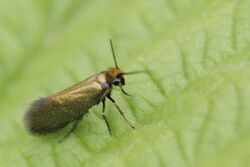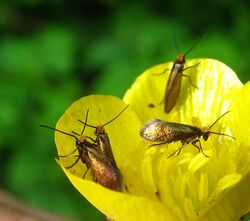Biology:Micropterix calthella
| Micropterix calthella | |
|---|---|

| |

| |
| Scientific classification | |
| Domain: | Eukaryota |
| Kingdom: | Animalia |
| Phylum: | Arthropoda |
| Class: | Insecta |
| Order: | Lepidoptera |
| Family: | Micropterigidae |
| Genus: | Micropterix |
| Species: | M. calthella
|
| Binomial name | |
| Micropterix calthella (Linnaeus, 1761)
| |
| Synonyms | |
|
List
| |
Micropterix calthella, the marsh marigold moth, is a species of moth belonging to the family Micropterigidae. It is found in damp habitats throughout Europe (except for the far south) and is also distributed eastwards to central Siberia. It was first described by Carl Linnaeus in 1761 as Phalaena calthella.
Description
Pupae are brown with dark oculi and paler abdominal segments.[1] Adults are small, with a forewing length of up to 4.6 millimetres (0.18 in) and a wingspan of 8–10 millimetres (0.31–0.39 in).[2] The species is more plainly marked than many other European species of Micropterix, and has dark bronze-coloured forewings with distinctive purple bases. The hindwings are rather dark bronzy-grey. The head is deep ferruginous-yellow.
Behaviour
Eggs are laid amongst vegetation on the soil surface. They are translucent white turning grey, prior to hatching. The larvae feed on tender, young growth of herbacaeous plants and pupate in a tough, silken cocoon.[3][4]
Like other members of the family, Micropterix calthella has functional jaws in its imaginal stage. As adult, it feeds on pollen grains from a wide variety of plants such as maple (Acer species), bugle (Ajuga species), Caltha, Cardamine, sedge (Carex species), hawthorn (Crataegus species), mercuries (Mercurialis species) and buttercup (Ranunculus species). The adults possess sociable behavior.
Lissan House, Cookstown, Northern Ireland; feeding on pollen of Ranunculus repens.
Taxonomy
The moth was first named by Carl Linnaeus in 1761 as Phalaena calthella, from a specimen found in Sweden.[3] The generic name Phalaena is from the Greek language and has a number of possible meanings. It may mean the rest of the moths; or possibly a devouring monster or whale, which may be derived from the destructive properties of clothes moths; or possibly from phallus an association by the Greeks of lepidoptera and semen, which was supposed to attract moths; or paros i.e. a light and the attraction of moths to lights. The specific name calthella, is named after the marsh marigold (Caltha palustris); the moth can be found feeding on its pollen.[5] Later the moth was renamed as Micropterix calthella, with the genus raised by the German entomologist, Jacob Hübner in 1825. It comes from the Greek for mikros – little, and pterux – a wing.[6]
References
- ↑ Patočka, Jan; Turčáni, Marek (2005). Lepidoptera pupae: Central European species. Text volume. Apollo Books. p. 30. ISBN 87-88757-47-1.
- ↑ "Micropterix calthella". UK Moths. https://ukmoths.org.uk/species/micropterix-calthella. Retrieved 9 June 2019.
- ↑ 3.0 3.1 Heath, John (1983). Micropterigidae. In The Moths and Butterflies of Great Britain and Ireland. Volume 1. Colchester: Harley Books. p. 151 & 154. ISBN 0 946589 15 1.
- ↑ Emmet, A M, ed (1988). A Field Guide to the Smaller British Lepidoptera (Second ed.). London: British Entomological and Natural History Society. p. 15.
- ↑ Emmet, A Maitland (1991). The Scientific Names of the British Lepidoptera. Their history and meaning. Colchester: Harley Books. pp. 18 and 42. ISBN 0 946589 35 6.
- ↑ Smith, Frank. "Microlepidoptera (Micro-Moths)". https://cisfbr.org.uk/MICRO%20DEMO%201.pdf. Retrieved 16 December 2021.
External links
Further reading
- Zeller-Lukashort, H. Christof (2007). "A review of Micropterix Hübner, 1825 from northern and central Europe (Micropterigidae)" (PDF). Nota Lepidopterologica 30 (2): 235–298. http://www.nkis.info/nkis/vortrag/03_Zeller.pdf.
- Meyrick, E., (1895) A Handbook of British Lepidoptera MacMillan, London (pdf
 This article incorporates text from this source, which is in the public domain. Keys and description page 806)
This article incorporates text from this source, which is in the public domain. Keys and description page 806)
Wikidata ☰ Q1304147 entry
 |



